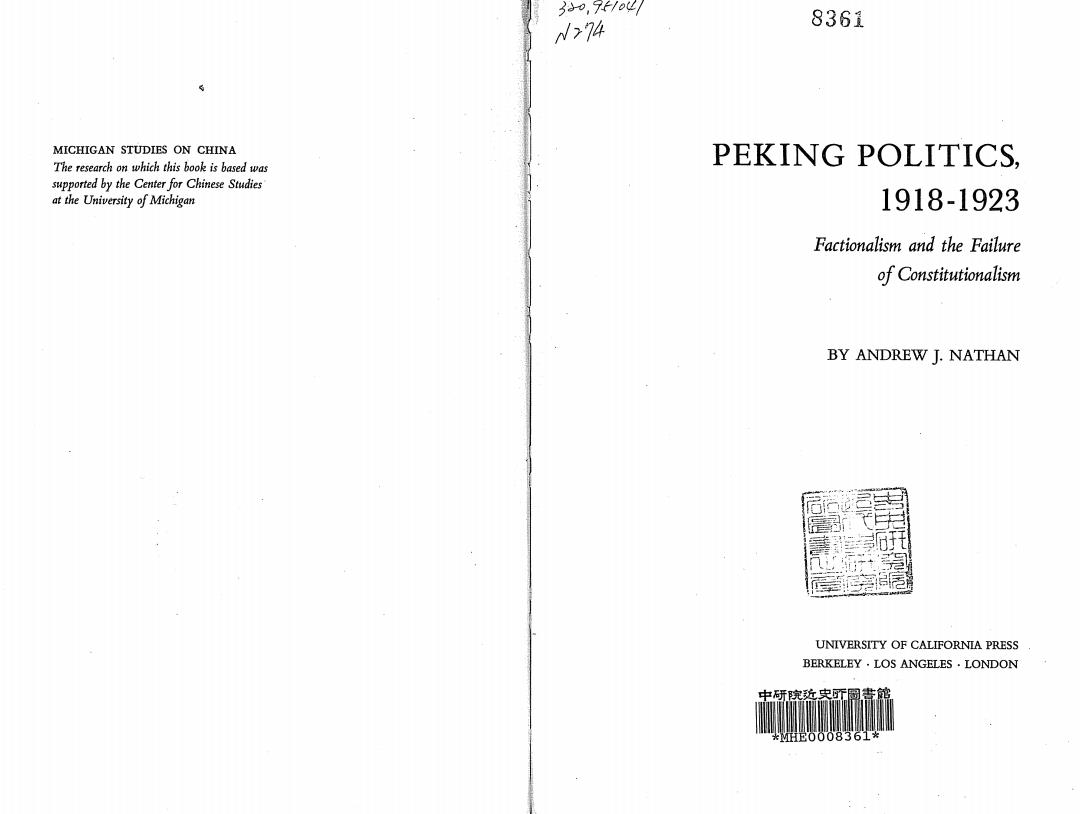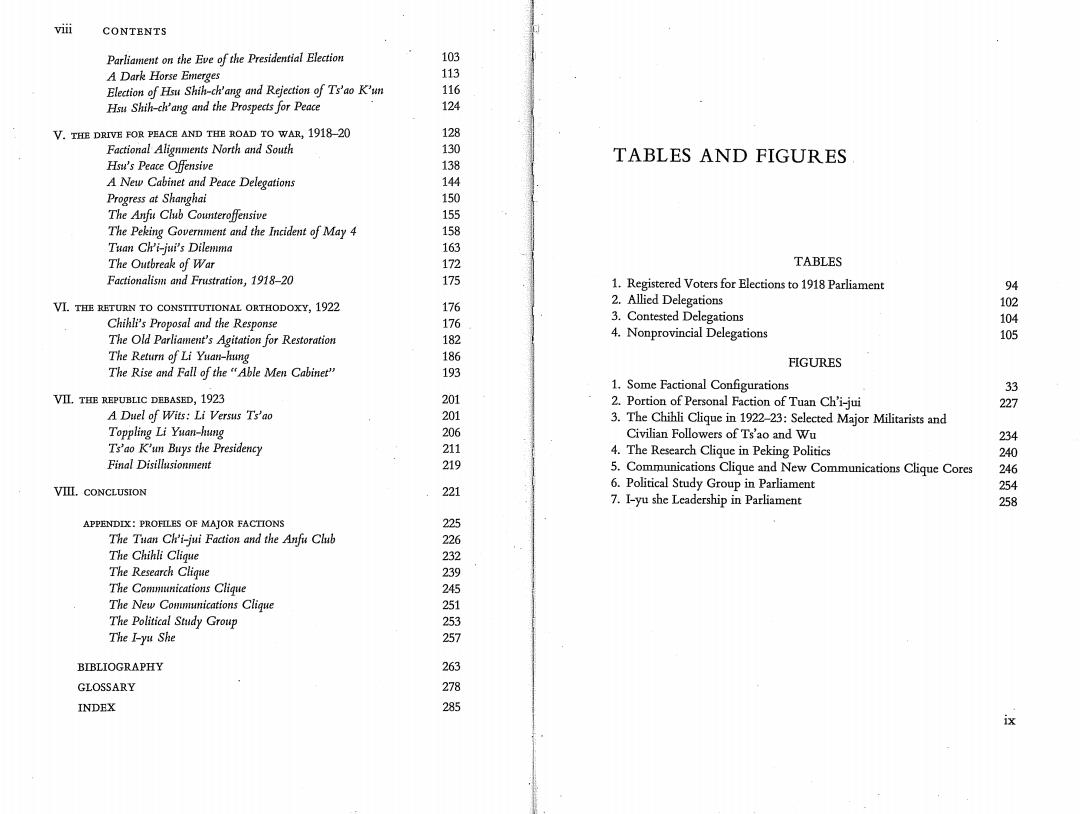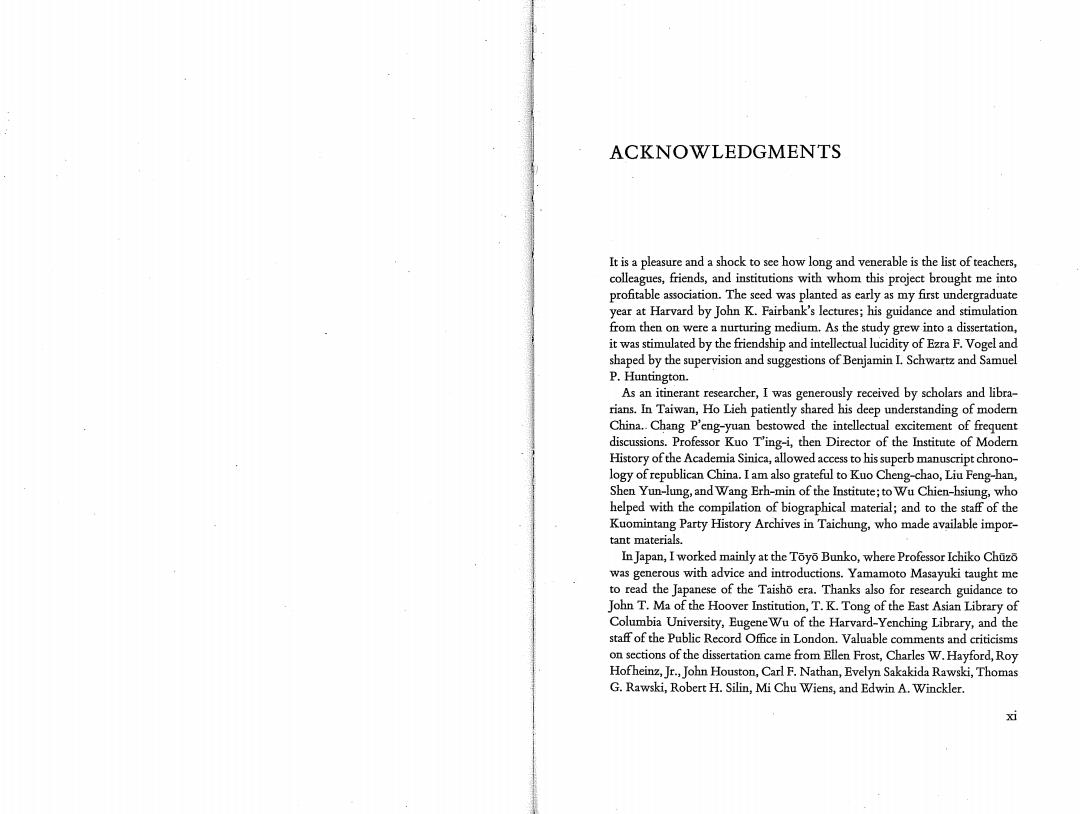
30,7f101 /274 8361 MICHIGAN STUDIES ON CHINA The research on which this book is based was PEKING POLITICS, supported by the Center for Chinese Studies at the University of Michigan 1918-1923 Factionalism and the Failure of Constitutionalism BY ANDREW J.NATHAN UNIVERSITY OF CALIFORNIA PRESS BERKELEY.LOS ANGELES LONDON

CONTENTS ACKNOWLEDGMENTS i A NOTE ON CURRENCY x CHRONOLOGY xv ABBREVIATIONS xix INTRODUCTION 1 I.CONSTITUTIONALISM AND IIS FAILURE Social Sources Intellectual Sources 18 The Problem of Failure 25 II.FACTIONALISM AND POLITICAL RECRUITMENT 27 Factions Defined 29 Structural Characteristics of Factions Characteristics of Factional Politics 37 Early Republican Factions 44 Political Recruitment and "Connections" 47 Connections,Factions,and the Failure of Constitutionalism 58 IIL.THE SETTING OF CONFLICT:THE PEKING GOVERNMENT,1916-28 59 Peking's Role and the Support of the Powers 59 Structure of the Peking Government 65 The Flavor of Peking Politics 69 Government Finance and the Role of the New-Style Banks 74 IV.THE RENEWAL OF LEGITIMACY,1918 9 The Election of Parliament 92 防

vii CONTENTS Parliament on the Eve of the Presidential Election 103 A Dark Horse Emerges 113 Election of Hsu Shih-ch'ang and Rejection of Ts'ao K'un 116 Hsu Shih-ch'ang and the Prospects for Peace 124 V.THE DRIVE FOR PEACE AND THE ROAD TO WAR,1918-20 128 Factional Alignments North and South 130 Hsu's Peace Ofensive 138 TABLES AND FIGURES A New Cabinet and Peace Delegations 144 Progress at Shanghai 150 The Anfu Club Counterofensive 155 The Peking Government and the Incident of May 4 158 Tuan Ch'i-jui's Dilemma 163 The Outbreak of War 172 TABLES Factionalism and Frustration,1918-20 175 1.Registered Voters for Elections to 1918 Parliament 94 VI.THE RETURN TO CONSTITUTIONAL ORTHODOXY,1922 176 2.Allied Delegations 102 Chihli's Proposal and the Response 176 3.Contested Delegations 104 The Old Parliament's Agitation for Restoration 182 4.Nonprovincial Delegations 105 The Return of Li Yuan-hung 186 FIGURES The Rise and Fall of the "Able Men Cabinet' 193 1.Some Factional Configurations 33 VII.THE REPUBLIC DEBASED,1923 201 2.Portion of Personal Faction of Tuan Ch'i-jui 227 A Duel of Wits:Li Versus Ts'ao 201 3.The Chihli Clique in 1922-23:Selected Major Militarists and Toppling Li Yuan-hung 206 Civilian Followers of Ts'ao and Wu 234 Ts'ao K'un Buys the Presidency 211 4.The Research Clique in Peking Politics 240 Final Disillusionment 219 5.Communications Clique and New Communications Clique Cores 246 VIIL.CONCLUSION 221 6.Political Study Group in Parliament 254 7.I-yu she Leadership in Parliament 258 APPENDIX:PROFILES OF MAJOR FACTIONS 225 The Tuan Ch'i-jui Faction and the Anfu Club 226 The Chihli Clique 232 The Research Clique 239 The Communications Clique 245 The New Communications Clique 251 The Political Study Group 253 The I-yu She 257 BIBLIOGRAPHY 263 GLOSSARY 278 INDEX 285 ix

ACKNOWLEDGMENTS It is a pleasure and a shock to see how long and venerable is the list of teachers, colleagues,friends,and institutions with whom this project brought me into profitable association.The seed was planted as carly as my first undergraduate year at Harvard by John K.Fairbank's lectures;his guidance and stimulation from then on were a nurturing medium.As the study grew into a dissertation, it was stimulated by the fricndship and intellectual lucidity of Ezra F.Vogel and shaped by the supervision and suggestions of Benjamin I.Schwartz and Samuel P.Huntington. As an itinerant researcher,I was generously received by scholars and libra- rians.In Taiwan,Ho Lieh patiently shared his deep understanding of modern China.Chang P'eng-yuan bestowed the intellectual excitement of frequent discussions.Professor Kuo T'ing-i,then Director of the Institute of Modern History of the Academia Sinica,allowed access to his superb manuscript chrono- logy of republican China.I am also grateful to Kuo Cheng-chao,Liu Feng-han, Shen Yun-lung,and Wang Erh-min of the Institute;to Wu Chien-hsiung,who helped with the compilation of biographical material;and to the staff of the Kuomintang Party History Archives in Taichung,who made available impor- tant materials. In Japan,I worked mainly at the Toyo Bunko,where Professor Ichiko Chuzo was generous with advice and introductions.Yamamoto Masayuki taught me to read the Japanese of the Taisho era.Thanks also for research guidance to John T.Ma of the Hoover Institution,T.K.Tong of the East Asian Library of Columbia University,Eugene Wu of the Harvard-Yenching Library,and the staff of the Public Record Office in London.Valuable comments and criticisms on sections of the dissertation came from Ellen Frost,Charles W.Hayford,Roy Hofheinz,Jr.,John Houston,Carl F.Nathan,Evelyn Sakakida Rawski,Thomas G.Rawski,Robert H.Silin,Mi Chu Wiens,and Edwin A.Winckler

xii ACKNOWLEDGMENTS After the dissertation came the equally important task of rethinking and rewriting.In an informal seminar on republican China at the Center for Chinese Studies of the University of Michigan,I received thoughtful and unstinting criticisms from Ch'i Hsi-sheng,Joseph W.Esherick,Albert Feuerwerker, Rhoads Murphey,Andrea Solomon,Ronald Suleski,and Ernest P.Young.At the East Asian Institute of Columbia University,sections of the manuscript received critical readings from Dorothy Borg,Richard C.Bush,Donald W. A NOTE ON CURRENCY Klein,Steven I.Levine,Kenneth Lieberthal,C.Martin Wilbur,and David C. Wilson.Thomas A.Metzger made valuable comments on Chapter I.Sharon G. Nathan helped clarify the factionalism model presented in Chapter II.Anony- mous readers for the Journal of Asian Studies and the University of California Press provided useful comments.The late Maeve Southgate wrestled with the problem of a title.Mervyn Adams Seldon skillfully edited the final manuscript. I wish also to draw attention to the names of those acknowledged in my China The average 1920 exchange rate at Shanghai in customs taels (an arbitrary Quarterly article,"A Factionalism Model for CCP Politics,"part of which standard used only in customs transactions)for the currencies mentioned in this reappears in Chapter Il.I am grateful to the Columbia University Press for book was as follows: permission to base the map in this volume on the map,"China in the Warlord One customs tael English 0 6s 9.5d Era,"in O.Edmund Clubb,Twentieth Century China (New York,1964);to =U.S.$1.24 Professor Clubb for lending me the original copy of that map;and to Henry =Japanese¥2.38 H.Wiggins and Lee Chong of the Press for helping arrange for revisions of the Mex.$1.58 or 1.58 Chinese yuan original. Shanghai taels 1.1140 In addition to the University of Michigan Center for Chinese Studies,this research received financial support from the National Defense Education Act The rates varied from month to month and year to year;in 1920,the exchange fellowship program,the Foreign Area Fellowship Program,the Columbia value of the customs tael was relatively high. University Council on the Social Sciences,the East Asian Institute of Columbia Mexican dollars,American trade dollars,and other foreign dollars,all stand- University,and the Guggenheim Foundation.Neither they nor my intellectual ing for the same intrinsic value,were brought into China from the mid- abettors can be held responsible for the study's errors and shortcomings,except nineteenth century on.In the late Ch'ing,provincial mints began to issue dollars, that without their help these would never have come to be sufficiently mixed taking the Mexican dollar as the standard of value.The various Chinese dollars with nonerrors and nonshortcomings to see the light of day. (yuan)such as the.Peiyang dollar (Tientsin),Ta-Ch'ing dollar (Tientsin), Szechwan dollar,Fengtien dollar,Kiangsu dollar,Sun Yat-sen dollar(Nanking), Li Yuan-hung dollar(Wuchang),and Yuan Shih-k'ai dollar (Tientsin)were exchanged at a premium or discount depending upon distance from the place of issue and other factors,while the Mexican dollar remained at par everywhere. From 1914 on,national government accounts and Chinese banking accounts were legally required to be expressed in yuan.Commercial transactions were often expressed in taels (of which there were many kinds).Most foreign obliga- tions of the Chinese Government were contracted in foreign currencies.Unless otherwise specified,figures are given in U.S.dollars. Sources:The China Year Book 1921-2,pp.286-88;The China Year Book 1924-5,p.699; A.W.Fervin,Chinese Currency and Finance (Washington,D.C1919),Pp.11-13. xiii